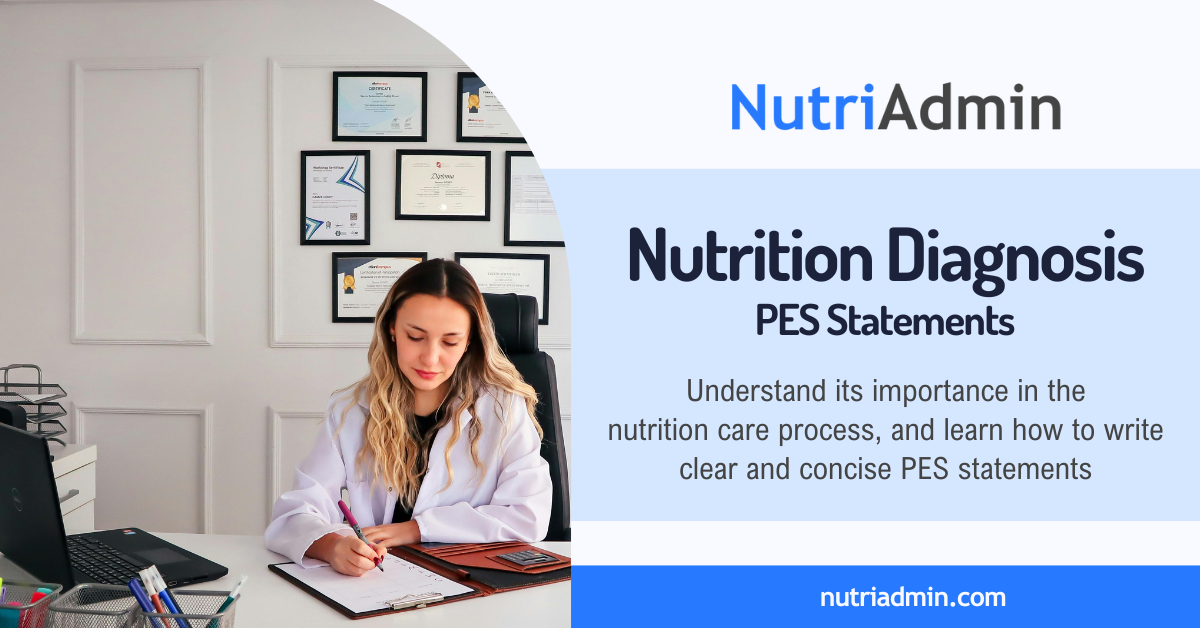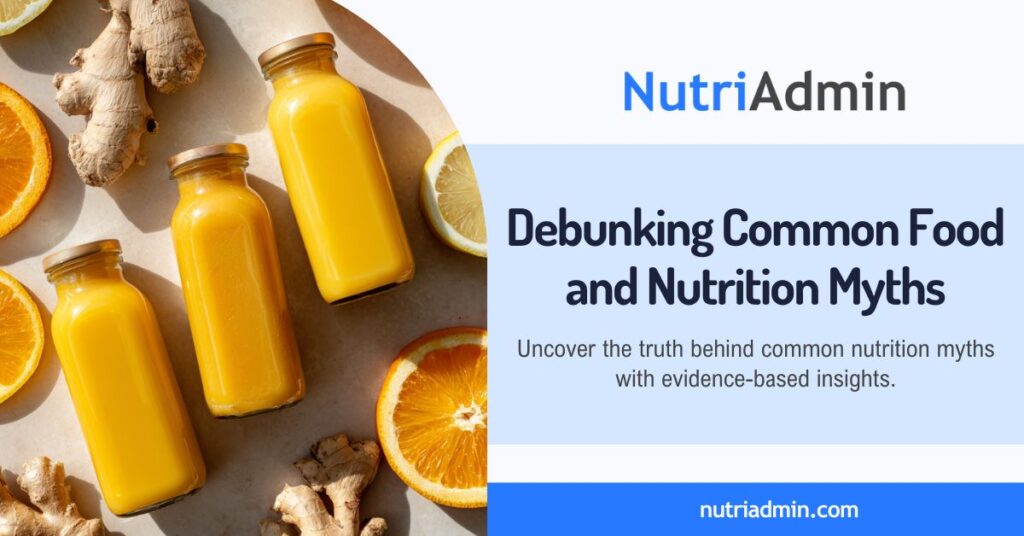As a nutrition student or a registered dietitian, it is important to develop a comprehensive understanding of nutrition diagnosis. This knowledge allows you to identify and address nutritional issues effectively. A vital component of this process is the ability to write clear and concise PES (Problem, Etiology, Signs/Symptoms) statements. These statements serve as a structured way to articulate a patient’s nutritional problem, the underlying causes, and the specific signs and symptoms that indicate the issue.
Learn how understanding nutrition diagnosis and creating effective PES statements are essential for developing personalized nutrition care plans that promote better health outcomes, whether you are in clinical, community, or private practice settings.
Nutrition Diagnosis
Nutrition diagnosis is the second step in the nutrition care process. It involves identifying and labeling nutritional problems based on assessment data. This diagnosis helps in developing an individualized nutrition care plan for clients.
A nutrition diagnosis is typically expressed in standardized language, using terms defined by organizations such as the Academy of Nutrition and Dietetics. This allows for clear communication among healthcare professionals.
Three Domains of Nutrition Diagnosis
Nutrition diagnoses are categorized into three domains:
| Nutrition Diagnosis Domain | Nutrition Diagnostic Terminology Examples |
|---|---|
| Intake-related Problems related to the quantity and quality of food and nutrient intake. | 1. Inadequate energy intake 2. Excessive protein intake 3. Inadequate intake of vitamin B12 4. Excessive fiber intake 5. Inadequate fluid intake 6. Increased nutrient needs |
| Clinical Nutritional issues stemming from medical conditions or physical symptoms. | 1. Swallowing difficulty 2. Unintended weight loss 3. Overweight/obesity 4. Food-medication interaction 5. Impaired nutrient utilization 6. Difficulty chewing |
| Behavioral-Environmental Factors affecting food choices and access. | 1. Food and nutrition-related knowledge deficit 2. Limited adherence to nutrition-related recommendations 3. Physical inactivity 4. Limited ability to prepare food for eating 5. Food insecurity 6. Self-feeding difficulty |
What Nutrition Diagnosis Is Not
Understanding nutrition diagnosis is important, but it’s also essential to recognize its limitations. There are several common misconceptions about nutrition diagnosis that can cause confusion. Below, we clarify what nutrition diagnosis is, not to define its purpose and application.
Medical Diagnosis
While it is related to medical conditions, it is different from medical diagnoses. It focuses specifically on the nutritional aspects rather than the broader medical issues.
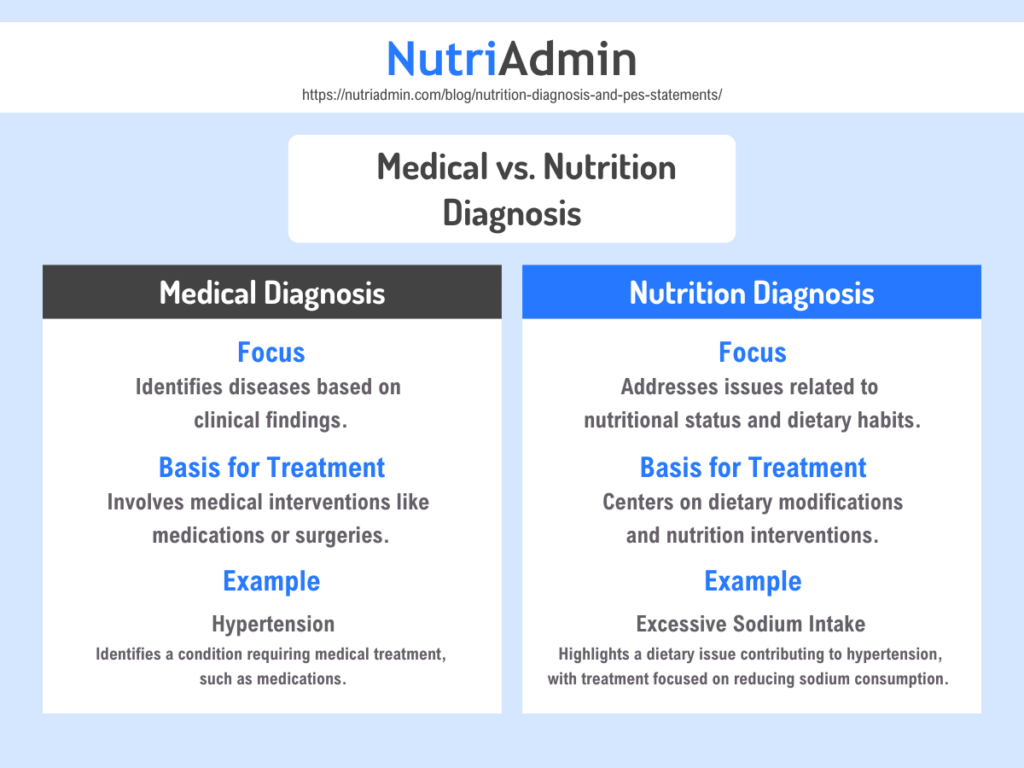
One-Size-Fits-All Approach
Nutrition diagnosis is individualized and does not universally apply to all patients with similar health conditions. It requires careful consideration of each person’s unique circumstances.
Solely Focusing on Symptoms
Although symptoms may play a role in identifying nutrition problems, the diagnosis goes beyond just recognizing symptoms to evaluate underlying causes and contributing factors.
Constant
Nutrition diagnoses can evolve over time based on changes in a person’s health status, dietary habits, and lifestyle, necessitating regular reassessment and adaptation of the care plan.
Treatment Plan
It is different from the intervention or treatment plan, which is the strategy developed to address the identified nutritional problem. However, it serves as the basis for designing interventions to address identified nutrition-related issues.
The Process of Nutrition Diagnosis
Data Collection and Assessment
Gather comprehensive information through client interviews, dietary recalls, nutritional assessments, and laboratory tests. This may include medical history, dietary habits, lifestyle factors, and physical measurements. Analyze this data to gain insights into the client’s overall nutritional status and identify any potential concerns.
Identifying Nutrition Problems
Based on the assessment, identify actual or potential nutrition problems. This might involve recognizing issues like underweight, obesity, or nutrient deficiencies.
Writing PES Statements
Create clear and concise PES statements to articulate the nutrition diagnosis. A PES statement is a structured way to write a nutrition diagnosis. This format helps nutrition professionals develop targeted interventions and track progress effectively.
It stands for:
- Problem: This describes the nutrition issue or diagnosis. It reflects an individual’s specific nutritional concern, such as “inadequate protein intake.”
- Etiology: This part identifies the root cause or factors contributing to the problem. For instance, it might include explanations like “due to lack of access to healthy foods” or “as a result of sedentary lifestyle.”
- Signs and Symptoms: This section provides evidence to support the diagnosis. It includes measurable or observable data, such as “BMI of 30” or “low albumin levels.”
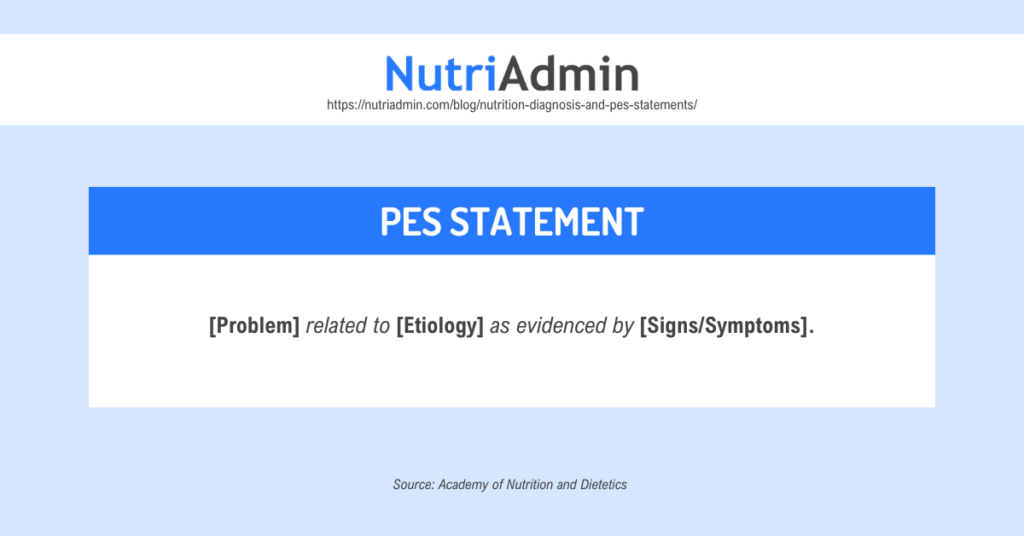
Prioritization of Diagnoses and Validation
Evaluate and prioritize identified nutrition diagnoses based on the severity, urgency, and potential impact on health. Focus on those that require immediate attention.
Confirm the nutrition diagnosis by reviewing and validating the findings with established guidelines and ensuring they align with best practices. This step may involve discussing findings with clients or other healthcare providers.
Documentation
Clearly document the nutrition diagnosis and PES statement in the client’s records to ensure consistent communication among healthcare providers.
Collaboration
Engage with other members of the healthcare team as necessary to address the nutrition diagnosis and develop a comprehensive care plan.
How to Write Clear and Concise PES Statements
As a dietitian, writing clear and concise PES statements is essential for outlining nutrition diagnoses in a structured manner. Here’s how to effectively construct these statements
- Identify the Problem: Clearly state the nutrition-related issue. Be specific about what the client is experiencing. For example, instead of a generic term like “nutrition deficiency,” use “inadequate protein intake.”
- Determine the Etiology: Describe the cause of the problem, which may include factors like dietary habits, medical conditions, or lifestyle choices. For instance, you might say, “related to limited access to affordable protein sources.”
- List the Symptoms: Provide evidence that supports your identification of the problem. Include specific signs, symptoms, or measurable indicators. For example, “as evidenced by weight loss of 5% over the last month and low serum albumin levels.”
- Be Concise: Aim for brevity while ensuring clarity. Use straightforward language and avoid lengthy explanations. Focus on essential information.
- Review and Revise: Take a moment to review your PES statement. Ensure it flows logically and that each component clearly connects to the others. This will help convey the diagnosis effectively.
PES Statements Examples
- Inadequate fiber intake related to limited consumption of high-fiber foods, as evidenced by food diary records showing an average of less than two servings of fruits, vegetables, and whole grains each week.
- Unintended weight gain related to increased appetite due to antidepressant medication, as evidenced by a 15% weight gain two months after starting the medication.
- Excessive sodium intake related to regular consumption of fast food and pre-packaged meals as evidenced by elevated blood pressure of 140/90 and fluid retention in the ankles and feet.
Common Mistakes in Writing PES Statements
- Squeezing in Multiple Problems: Avoid including multiple nutrition problems in one PES statement. Focus on a single issue to ensure clarity and targeted intervention.
- Using Medical Diagnosis Instead of Nutritional Diagnosis: Ensure that the PES statement reflects a nutritional diagnosis rather than a medical diagnosis. This will help you, as a nutrition professional, create a nutrition care plan that can address the client’s specific nutritional needs.
- Lack of Connection Between Nutrition Problem and Etiology: Make sure the nutrition problem is directly linked to its etiology (causes) as well as the signs and symptoms observed. Each component should work together to provide a clear understanding of the issue.
- Inconsistency with Nutritional Assessment Data: The PES statement must align with the data collected during the nutritional assessment. Any discrepancies can lead to ineffective interventions and misaligned care strategies.
- Specificity of Signs and Symptoms: Use specific signs and symptoms in the PES statement to enable effective monitoring of the nutrition problem. Vague descriptions can hinder the ability to track progress and evaluate the effectiveness of interventions.
Documenting Nutrition Diagnosis
There are several methods for documenting your clients’ nutrition diagnoses, each with its own benefits.
Free options include using a printed template, Word document, or spreadsheet, which allows you to store your client information at no cost.
Alternatively, professional nutrition software can enhance this process. These programs provide easy-to-use interfaces, pre-designed templates, and additional helpful features such as practice management tools, nutritional analysis, and meal planning functionalities. Investing in such software can enhance efficiency and elevate the quality of care you provide.
Whichever method you choose, it’s important to keep your documentation clear and accessible for effective communication with your clients.
Nutrition Diagnosis in NutriAdmin
During the pandemic, when almost everything was put on pause, many of us learned to appreciate technology and the internet, which enabled us to continue assisting clients through online services.
How about you?
Have you taken steps to clear away the clutter of printed forms, or are you still struggling with the ever-growing pile on your desk?
Are you ready to regain control and create a more organized workspace?
If you’re ready to take the first step, NutriAdmin can assist you. It is an all-in-one software for nutritionists and dietitians. It allows you to securely store your clients’ data and features various practice management tools that effectively streamline your nutrition business.
If you need to document your client’s nutrition diagnosis, care plan, or follow-up sessions, you can utilize the Private Notes feature. This feature functions similarly to your consultation notes or any other client record templates you typically use.
You can create a private note template tailored to your preferences. Incorporating various field types, such as dates, can save time when entering information and help you keep track of updated nutrition diagnoses.
You can use text fields to type your PES statements, or if you specialize in a specific client base and frequently use certain nutrition diagnostic terminologies for nutrition problems, you can choose a dropdown option. This way, you won’t have to type out longer terminologies each time.
These are just three examples of the many field types that you can choose from!
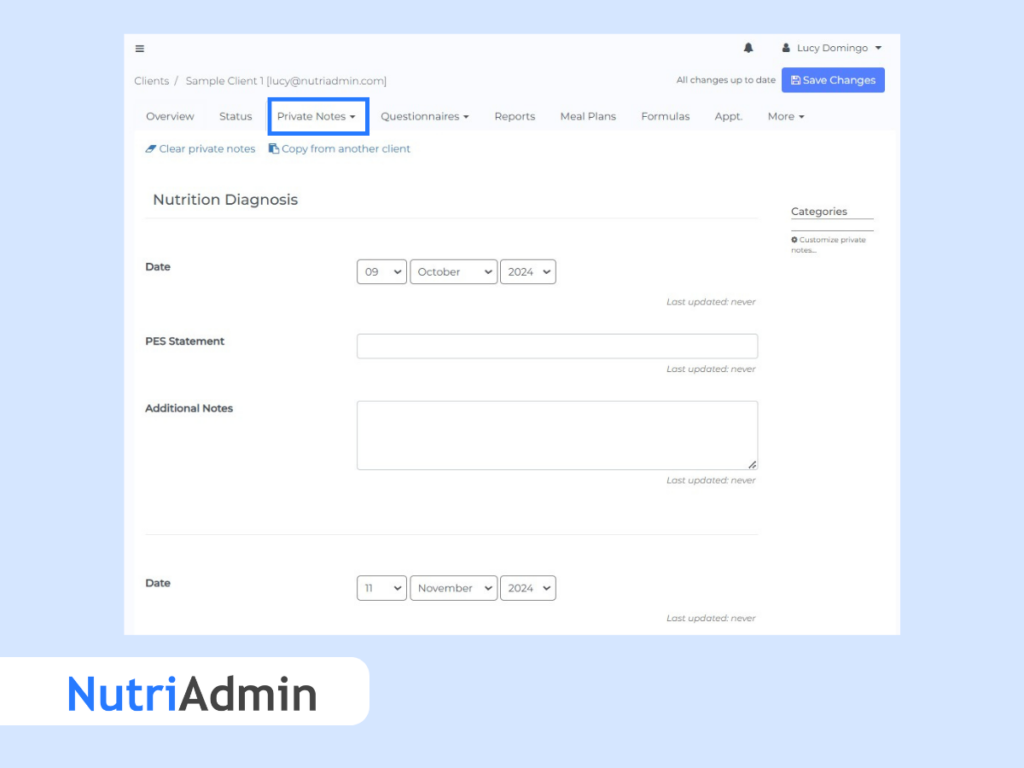
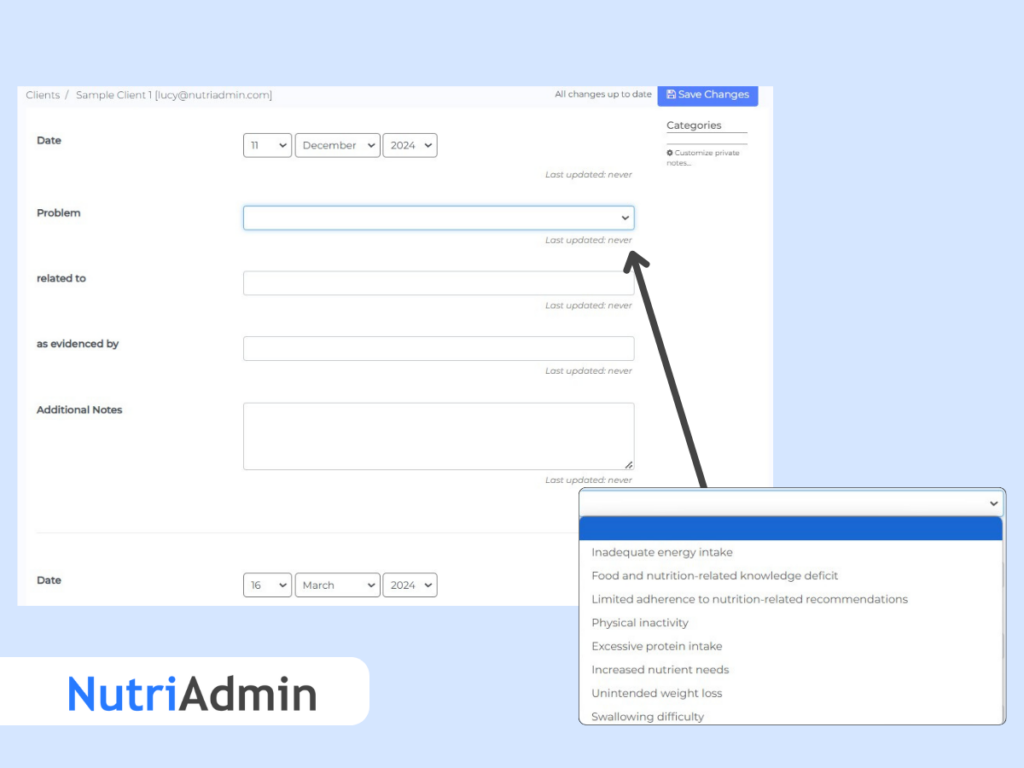
Summary
Nutrition diagnosis is the second step in the nutrition care process. Dietitians use standardized terminology to document nutritional problems. It covers three domains: intake-related problems like inadequate energy intake, clinical issues such as swallowing difficulties, and behavioral-environmental factors, including food insecurity.
Creating PES statements is a structured way to write a nutrition diagnosis. A PES statement consists of three components: the Problem, which identifies the specific issue; the Etiology, which explains the root cause; and the Signs/Symptoms, which provide measurable evidence.
It is important to avoid common mistakes, such as including multiple problems or using vague descriptions, to ensure clarity and effectiveness.
